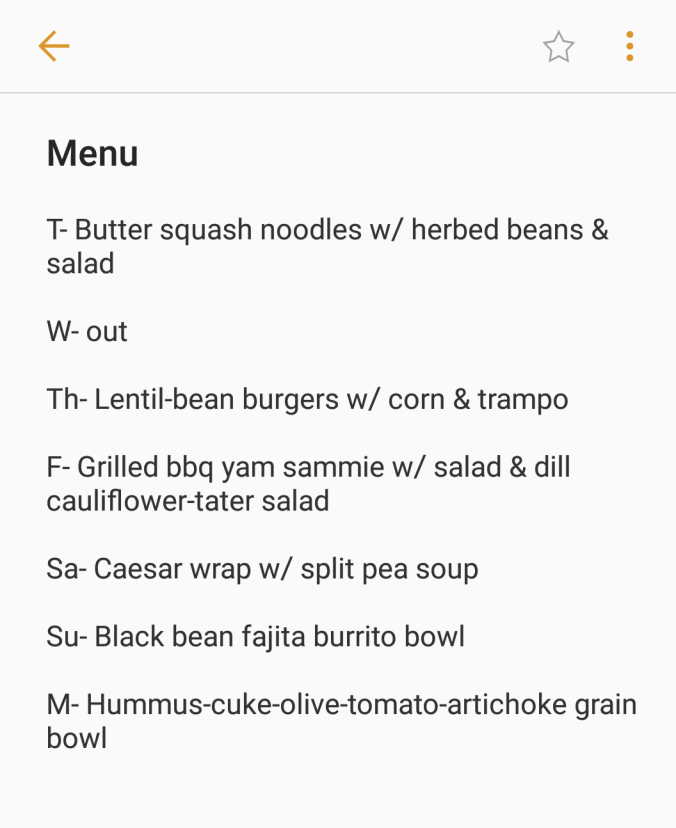Back-to-school can mean even nuttier evenings than usual with homework and extracurriculars, worn-out kids and snack demands. So how do I minimize the chaos? Meal planning.
I used to wait until lunchtime to figure out dinner. Not only did that add to my stress level, stacking another task on my harried afternoon, but it often left me racing to the store for last-minute ingredients — which amped up the grocery bill — or I simply wound up making the same tired three or four meals on rotation, since we generally had the necessary ingredients in the house. Then I began meal planning.
Not only did my stress level diminish because there was no rush to figure out meals, but our grocery bill declined too. And, guess What? We ate better!
How do I meal plan? I go pretty low-tech compared to some, but this is my process.
1) Look to the calendar. Every week I sit down and plan out the meals according to our calendar. If I have a mom date one night, The Hubs is in charge of dinner so I don’t bother planning a meal for that day. If it’s supposed to be beautiful one day and The Hubs isn’t slotted to be busy with work, I’ll be sure to plan a grillable meal. If I know we have a packed afternoon one day, I plan an easy meal.
2) Special requests, anyone? Before finalizing the meal plan, I ask the kids and The Hubs if they have any meal requests for the following week. Then I try to incorporate those menu items.
3) Write it down. Simply using the Memo app on my phone, I type out my week’s meal plan.

4) List it out. After creating the menu, I go to my preferred grocery store’s app and create my grocery list. Before adding the frequently purchased items, I make sure the ingredients for each menu item are on my list. Then, I add the usual staple products.

Grocery list on the store app
5) Abide by the list. The biggest part of meal planning isn’t devising a menu or creating a comprehensive grocery list, it’s sticking to the plan. At first, it can be tempting to wing it and go back to old habits of take-out or frozen meals. Forcing yourself to stick to meal planning is the key to its success. After a few weeks, it simply becomes habit.
Looking to shave even more money off of your grocery bill? Here are some easy ways to go about it.
1) Circulars and coupons. Check out local stores’ circulars and coupons then design your menu around deals.
2) In-season shopping. Buying produce that’s in-season is a major money saver. Apples and butternut squash in fall, zucchini and tomatoes in summer. Let the season’s produce inspire your menu.
3) Fresh over premade. The fewer processed items you buy, the cheaper and healthier your meals will be. Instead of buying a box of seasoned rice, stir your own pantry herbs into plain homemade rice. Instead of opting for a tub of guacamole, mash up your own. Not an inventive cook? There are tons of recipes online. Google is your friend.
4) Go meat-free (or low-meat). Since dropping meat, our grocery bill has been $50-$100 less every week compared to when we ate meat daily. The less meat you buy, the less you pay at the register. Beans, lentils, and other plant-based (unprocessed) protein sources are widely cheaper and healthier than animal protein. Compare the cost and nutritionals of a can of beans or a bag of lentils to a platter of chicken breasts or a pouch of ground beef, and you may be a plant-eater more often.
5) Buy in bulk. If space and finances allow, buy staple items in bulk. Just be careful not to purchase products simply because they’re available in bulk or on sale. This would not be the time to make impulse or experimental buys. Stick to tried-and-trues. If you won’t use it, don’t buy it.
Now that you have the know-how, get planning! Make your afternoons a bit less stressful and your evenings a bit smoother with a little extra planning. You deserve it!